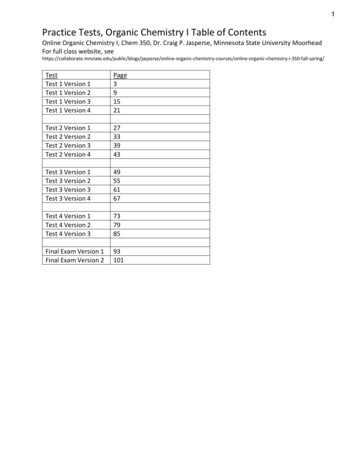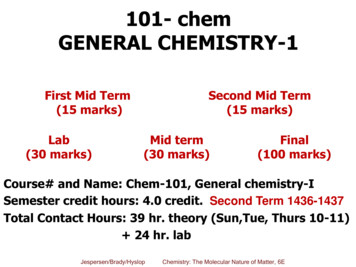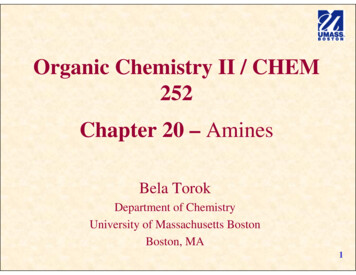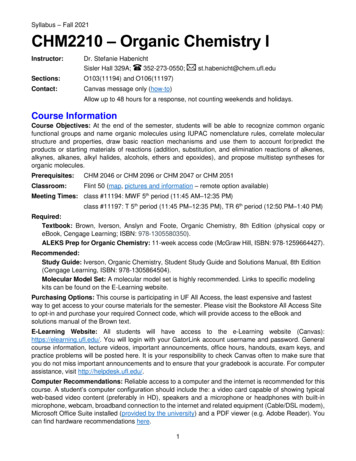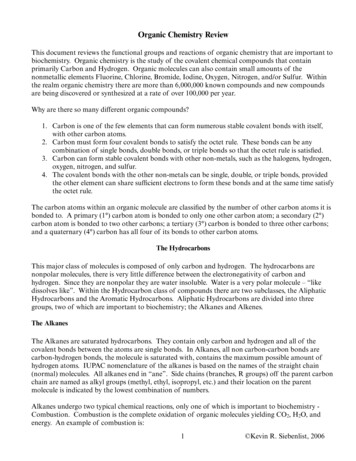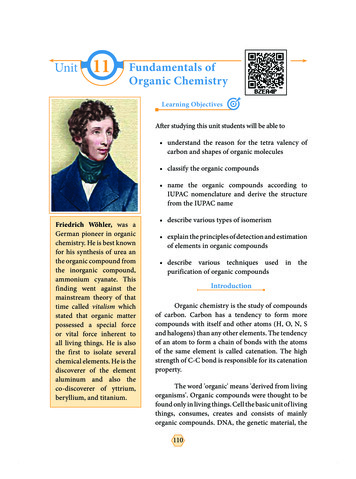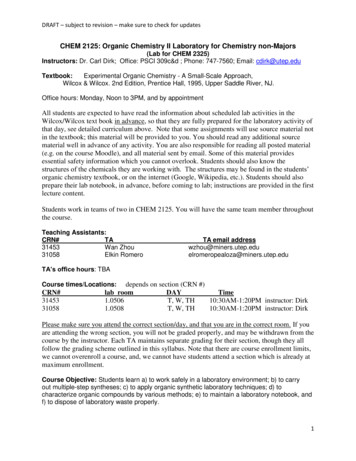
Transcription
DRAFT – subject to revision – make sure to check for updatesCHEM 2125: Organic Chemistry II Laboratory for Chemistry non-Majors(Lab for CHEM 2325)Instructors: Dr. Carl Dirk; Office: PSCI 309c&d ; Phone: 747-7560; Email: cdirk@utep.eduTextbook:Experimental Organic Chemistry - A Small-Scale Approach,Wilcox & Wilcox. 2nd Edition, Prentice Hall, 1995, Upper Saddle River, NJ.Office hours: Monday, Noon to 3PM, and by appointmentAll students are expected to have read the information about scheduled lab activities in theWilcox/Wilcox text book in advance, so that they are fully prepared for the laboratory activity ofthat day, see detailed curriculum above. Note that some assignments will use source material notin the textbook; this material will be provided to you. You should read any additional sourcematerial well in advance of any activity. You are also responsible for reading all posted material(e.g. on the course Moodle), and all material sent by email. Some of this material providesessential safety information which you cannot overlook. Students should also know thestructures of the chemicals they are working with. The structures may be found in the students’organic chemistry textbook, or on the internet (Google, Wikipedia, etc.). Students should alsoprepare their lab notebook, in advance, before coming to lab; instructions are provided in the firstlecture content.Students work in teams of two in CHEM 2125. You will have the same team member throughoutthe course.Teaching Assistants:CRN#TA31453Wan Zhou31058Elkin RomeroTA email .utep.eduTA’s office hours: TBAdepends on section (CRN #)lab roomDAYTime1.0506T, W, TH10:30AM-1:20PM instructor: Dirk1.0508T, W, TH10:30AM-1:20PM instructor: DirkCourse times/Locations:CRN#3145331058Please make sure you attend the correct section/day, and that you are in the correct room. If youare attending the wrong section, you will not be graded properly, and may be withdrawn from thecourse by the instructor. Each TA maintains separate grading for their section, though they allfollow the grading scheme outlined in this syllabus. Note that there are course enrollment limits,we cannot overenroll a course, and, we cannot have students attend a section which is already atmaximum enrollment.Course Objective: Students learn a) to work safely in a laboratory environment; b) to carryout multiple-step syntheses; c) to apply organic synthetic laboratory techniques; d) tocharacterize organic compounds by various methods; e) to maintain a laboratory notebook, andf) to dispose of laboratory waste properly.1
DRAFT – subject to revision – make sure to check for updatesCurriculum: CHEM 2125 involves learning some more thorough reaction and syntheticoperations than explored in CHEM 2124Some Essential dates:(In the event of a discrepancy of these dates with the official university calendar, theuniversity calendar prevails. Please check the university calendar to assure essential dates)July 10 – Summer II 2018 semester begins. This is also the first day of classes for CHEM2125. Do not miss the first day of class as there is an essential safety discussion, and should youmiss, you will be required to write a safety report (see below).July 27 – Course drop deadline. The last day to receive a W.August 3 – Last Day of classes; note that the last day for CHEM 2125 will be August 2.GRADING:The grades for the laboratory will consist of:1/3 Attendance, comportment, preparation, and compliance with safety and cleanlinessguidelines.1/3 Lab Reports (completed on-line through organic.utep.edu)1/3 Quizzes(completed on-line through organic.utep.edu)Note below the 25% penalty on your attendance/comportment/compliance/etc. grade should youmiss the safety lecture (first day of class). A 25% penalty on this grade might mean that thehighest grade you can earn in the class is B.Your attendance grade encompasses many factors. Your TA or instructor can deduct from thisgrade if you appear poorly prepared, do not follow instructions, do not comport yourself well inclass, fail to follow safety requirements (such as failing to wear safety goggles), or fail to cleanup your work area and contribute to general cleanliness throughout the lab.Grades will follow the following scheme:90-100:A80- 90:B70- 80:C60- 70:D 60:FThere are no final exams in this course.Pre-lab QUIZZINGQuizzes will be administered on-line through a Moodle learning system, through the link:organic.utep.edu. You will be provided with a LOGIN to the system prior to the first quiz. A newquiz will be posted on the system at 1:30PM the day before any a lab activity. It will be due at8AM the morning of the activity. There are no extensions of the quiz period. It is yourresponsibility to check for quiz open and due times/dates to assure you do not miss a quiz. Thefirst quiz will be available online at 1:30PM on Tuesday, July 10, and is due on Wednesday8AM of July 11, 2018. The intent of prelab quizzing is to assure that you have preparedadequately for each lab session. Preparing for each new lab requires you to consult with your2
DRAFT – subject to revision – make sure to check for updatesbook, syllabus, material posted online, and the material presented by your TA. Note that allquizzes are normalized to 0-100 regardless of the number or value of individual questions.Lab Report: Your lab report will also be completed on-line through organic.utep.edu. Duringthe summer, the reports for all activities for the week become available at 1;30PM of Thursdayof that week, and are due at Noon (12) of Saturday of that week. There are no extensions of thereport period. Your first two reports will be available at 1;30PM on Thursday, July 12, and aredue on Saturday, noon, of July 14, 2018. Typically, each week, you will have 2-4 reports tocomplete. Note that all reports are normalized to 0-100 regardless of the number or value ofindividual questions.Note that pre-lab quizzes and lab reports are designed to be completed within 20-60 minutes,each, if you have made yourself well informed on the activity content. However, do not waituntil close to the deadline as you may need to have time to consult with your book, notes,lecture-slides, course Moodle content, etc.Attendance Policy:Your TA can deduct credit if you are late. Missing too many lab meetings, or being late,will render you susceptible to involuntary instructor initiated withdrawal from the course.Missing the first lab meeting, at which safety is discussed, will render you susceptible toinstructor initiated withdrawal from the course. This is because safety is essential information inorder to participate in the course.During the Summer, with the accelerated daily schedule, there is no capability to make upa missed day. If you believe you will miss any days that this course meets during the Summer,you should instead register for this course at a different time. If you are absent for a day, you willreceive a 100% deduction in your attendance grade.Consequence of missing the safety lecture – first day of classThe safety lecture takes place the first day of class. Your attendance of the safety lectureis essential to the safety of you, your classmates, and your TA. Previous safety lectures in othercourses do not release you from the obligation to attend this lecture. You receive a grade forattending this lecture. Should you be absent for the safety lecture:1. You will lose credit for the entire day’s activities.2. The instructor of record reserves the right to withdraw you from the course.3. You are required to submit a five page single space report on safety in the organiclaboratory, using the slides presented by your TA as primary source material. You haveone week from your missed safety lecture to complete this requirement. Should you failto adequately complete this assignment by the deadline, you will lose 25% of yourattendance/compliance/comportment/safety grade for the entire course. Your Instructor ofRecord will assess whether your report is adequate. Note that a loss of 25% of this gradeby failing to complete the report would likely mean at least one letter grade reduction forthe course.Unauthorized activities3
DRAFT – subject to revision – make sure to check for updatesNeither you or your TA are authorized to execute activities that are not part of the coursecurriculum. Consult with your instructor of record if you believe you must conduct a chemical orinstrumental activity that is not part of the course curriculum.Contribution to lab cleanliness:Cleanliness is part of your grade. If you depart from a class meeting without properlycontributing to cleaning your station and helping to maintain the lab tidiness, your TA willdeduct from your grade. You will also be expected to contribute to maintaining the cleanliness ofthe balance room, chemical dispensing, and waste handling areas of the lab. If your TA findsyour glassware or work area not properly cleaned, or, you have failed to help keep clean thebalance, chemical dispensing, and waste handling areas of the lab, this will be deducted fromyour grade.Your notebook:Guidance for maintaining your notebook will be discussed in class at the first classmeeting, or may be summarized on Moodle course postings at organic.utep.eduPrior to coming to lab, you should come prepared with, for instance, calculations already workedout in your notebook for operations you will undertake in the lab. Your TA may periodicallydemand to see your notebook. If you are not maintaining an adequate notebook, your TA maydeduct from your attendance/etc. grade.Communication:In order for students to be well prepared for the course and work safely, communicationis essential. You are required to check your email daily, throughout the semester, forannouncements dealing with various elements of the course. It is your responsibility to assurethat the email address under which you are registered is correct and functioning. You should alsocheck the course Moodle frequently for updates.Your TA & TA’s pre-lab lecture:Your main point of contact will be your Teaching Assistant (TA). By the day of check-in and thesafety lecture, your TA should be determined and your TA will check you in, administer andteach the course.Your TA will lecture on content for the present day’s activities and may also comment onupcoming activities for future scheduled lab days. You will be provided online with a draft ofanticipated slide content for the TA’s presentations. Note that TAs often augment this draftcontent with additional or different content, and may have to make some last minute adjustmentsin procedures. You should pay close attention to the TA’s presentations. Attendance to the prelaboratory lecture is mandatory. If you miss the pre-lab lecture, your TA will deduct from yourgrade, and you will be subject to instructor initiated withdrawal from the course.Your hood and bench:4
DRAFT – subject to revision – make sure to check for updatesNote that hoods and benches are labeled, and you will always work in the samehood/bench. ALL chemical activities are done in the hood. The bench is for maintaining yournotebook and supplies for your activity. Please make sure that labeled equipment remains in thehood or on the bench that matches that labeling.If your course section needs to keep chemical intermediates from one day to the next,each section has been provided with a locker for storage. Please consult with you TA for storageof compounds and materials from one day to the next.The Weighing Room, Dispensing hood and handling chemicals1) Do not leave chemical bottles or loose chemicals in the weighing room2) Clean up after yourselfa. Do not leave chemical spills you caused, Clean them up.b. If you need help with a clean-up, ask your TA for advice3) Many chemicals are hygroscopic, and will absorb moisture through from the air, ruiningthem for further use. For example MgSO4 or CaCl2. Please tightly close containers thatyou opened.4) Many chemicals are volatile and will evaporate away. Please tightly close containers thatyou opened.5) How you handle chemicals and responsible clean-up will be part of your grade.Students will work in teams of two. You will either be assigned or may be able to choose alab partner. You will continue with the same lab partner for all activities throughout the semesterAcademic Honesty: Materials submitted to fulfill academic requirements must represent thesubmitting student’s own efforts. Any act of academic dishonesty attempted by a UTEP studentis unacceptable and will not be tolerated. Violations will be taken seriously and will be referredto the Dean of Students Office for disciplinary action.Students with Disabilities: If you have or suspect a disability and need accommodations, youshould contact The Center for Accommodations and Support Services (CASS) at 747-5148 or atcass@utep.edu or room 106 Union East Building. The faculty member and TA cannot judgewhether you need accommodation for a disability. This must be done by CASS, which willadvise us how we should best accommodate specialized needs.Safety: You are required to follow all the safety rules and procedures in the laboratory.Missing the first lab meeting at which safety is discussed places you and your classmates at risk,and, will render you susceptible to involuntary instructor initiated withdrawal from the course. Ifyou miss the safety lecture, please check to make sure that you have not been withdrawn fromthe course.Summary of some important safety rules: Always know the danger of the chemicals you are working with, e.g. sulfuric acid. Youshould research the safety and chemical reactivity of all reagents before coming to class and askyour TA if you have any further questions. Always wear goggles. This is a State law. You do not have the choice to not comply. Always wear lab coats Know where the eye wash, safety shower, and fire extinguisher are located. Your TAshould brief you on how these work.5
DRAFT – subject to revision – make sure to check for updates Wear closed shoes. Your foot must be completely enclosed with no toes showing. Thisis because the floor may be commonly contaminated with chemicals and small shards of brokenglass. Long hair must be tied back Wear long pants (no skirts or shorts) No hats No food/drink items are allowed in a chemistry laboratory Keep your work space clean!!!!! If there is a chemical spill, inform the TA immediately. If you are injured (a cut, inhalation of toxic gases, acid burn on skin, etc.) inform yourTA immediately. We are required to file reports of all injuries, no matter how minor, and also tooffer you the option to seek medical aid. Do not wear your lab coat or gloves outside the lab in the area in the location ofStarbucks.Do not enter the lab until your TA has arrived. Unsupervised students are notpermitted in the lab.More detailed safety information:1) Eye Protection: Goggles: GOGGLES MUST BE WORN IN THE LAB AT ALL TIMES.As soon as you enter the lab, you should have your safety goggles on, regardless ofwhether any laboratory activity is underway. You cannot remove your safety gogglesuntil you leave the lab. Students who refuse to comply with safety goggle rules will beasked to leave the lab, and in the event they refuse to leave, will be escorted out byUniversity police. At the end of this syllabus, we illustrate what kind of Safety Gogglesyou must use.a. For those who wear contact lenses, we want to advise that injuries can often bemore severe in the event of a chemical splash into the eye. We recommend that, ifpossible, you choose to wear glasses under your goggles, instead of contactlenses.2) Hot Glassware: Hot glassware looks the same as cold glassware. Use care when workingwith a reaction apparatus that is being heated or with the glassware that may be attachedto or removed from the apparatus, as hot glass cannot be distinguished from cold glass3) Hot Plates: A hot hot-plate looks the same as cold hot-plate. Use the same care as you usewith glassware which may be hot. Note that some hot-plates possess a warning displaylight to indicate that the plate may be too hot to touch. This display light may fail (orwon’t operate if the hot-plate is unplugged, but still is hot), which means you should notrely on the display light to indicate the plate is hot. Note that some older models of hotplates may not possess a hot display light, or, instead possess an on/off indicator light.This on/off light does not indicate if a hot-plate is hot or not, only if it is on or not. Evenafter a plate has been turned off or unplugged, it can remain hot enough to cause a seriousburn.4) Liquid hazardsa. Hot solutions – always use great care when adding anything to a hot solution. Thematerial that you add can serve as a nucleation site for bubble formation, and thesolution can foam or erupt, sometimes violently from the flask/beaker6
DRAFT – subject to revision – make sure to check for updates5)6)7)8)9)b. Heat of mixing – many things, when they mix, generate heat, sometimesexplosively. For example, use great care when mixing acids and water. To reducethe heat of mixing, always add acid to the water. Never add water to the acid.c. Never look directly into a flask or beaker while working with it. Reactions, hotsolution eruptions, heat of mixing effects can cause the material in the flask orbeaker to erupt or eject toward you.Broken glassware. If glassware breaks in the lab, use extreme care in handling it. If youneed assistance, ask your TA. Broken glassware should be placed in the broken glasswarecontainer, NOT in trash containers.a. Note that long narrow glass objects such as thermometers, glass pipettes, glasstubing and glass rods easily break and can easily then penetrate the skin causingserious cuts and penetrating wounds. Do not apply bending forces to theseobjects. For example do not try to force a tube or thermometer through a stopper(with a hole). This results in a common hand injury when the tube or thermometerbreaks. The correct approach is to hold the thermometer close to the stopperopening and push through slowly in increments of fractions of an inch. Seekassistance from your TA on this.b. Because small shards of broken glass can remain on the floor for long periods oftime, you cannot wear open shoes such as sandals. The shoe should completelyenclose your lower foot and toes.Chemical waste disposal. Make sure you seek guidance from your TA in disposal ofchemical waste. Some waste containers are only meant for certain kinds of waste. Mixingthe wrong chemical waste can produce a violent chemical reaction and/or fire.a. Solid waste and gloves should be placed into the bins/drums (usually blue incolor)b. Liquid waste should be placed in one of three labeled containers in the wastehood:i. Organic non-halogenated: This would be all liquid or solution organicwaste that does not contain a halogen (F, Cl, Br, I) atom.ii. Organic halogenated: This would be all liquid or solution organic wastethat does contain a halogen atom.iii. Aqueous waste: This would be all waste that is in water.c. Log waste into designated waste sheets. When you add waste to a bottle, thereshould be available a log-in sheet to account what and how much you have addedto the bottle.Trash: There is a trash bin the lab. Do not put gloves, chemicals or broken glassware inthe trash bin. Do not put anything contaminated with chemicals into the trash bin. Thecustodial staff can be harmed by chemicals or broken glassware.Injuries: All injuries must be reported to your TA.Fire: Treat all organic compounds as being flammable. Note that open flames are rarelycreated in the lab as part of a lab procedure. However, vapors can be ignited by hotsurfaces. In the event of a fire, alert your TA and classmates. None of you are firefighters. Your first consideration has to be your safety and that of others, which meansevacuation to a safe location is the priority. When you and your TA are safe, the fireshould be reported. Your TA/instructor may take some action to extinguish a fire basedon their own judgment of whether this can be done safely.7
DRAFT – subject to revision – make sure to check for updatesa. There are nearby sources of water that can be used to extinguish clothing on fire.One source is the shower just outside the main door of the room. The other is theeye wash hose at each sink which can be drawn out some distance to dousesomeone.i. Your TA should show the location and illustrate means of use for theshower and eyewashes. If your TA has not done this, please ask him/her todo so for the class.b. A fire extinguisher should also be available to extinguish a fire. Always aim theextinguisher at the base of the flame.c. Clothing that you wear to the lab should be under control, so that sleeves orbottoms of shirts cannot easily be contaminated with chemicals or are floppyenough to be ignited by a flame.i. Choose carefully what to wear to the lab. Your clothing may also bedamaged by chemicals, so you should choose clothing that you might bewilling to discard.d. Hair can easily catch fire and burn. Also, uncontrolled hair can be more easilycontaminated by chemicals. Keep loose hair under control and tied back.e. When heating anything, keep your face away from the opening of the glassware,as a sudden flash or explosion could more likely propel material toward you.10) Chemical exposure: Most, if not all organic compounds can pass through the skin. Thesubstances we use, or which you might encounter, could have varying toxicity anddanger. Many are skin irritants. Some are respiratory irritants; avoid inhalation; do notattempt to smell the odor of substances as this could cause nasal or respiratory distress.You will also be working with organic and inorganic acids and bases, and other inorganicsubstances. The hazards of these substances are spelled out in the Materials Safety DataSheet for each substance.a. Avoid getting anything on the skin, and wash your hands and arms when youcomplete the lab. You must wear protective gloves when working in the lab.While your TA/instructor or the faculty can answer some questions about thesafety of the chemicals you encounter, we are not fully expert on all of the toxicand pharmacological properties. Additional questions may be referred to UTEPEnvironmental Health & Safety.b. Treat all surfaces in the lab as contaminated. Do not sit or lean on benches orhoods.11) Gloves: You will be supplied with gloves to use to protect your hands. Do not take thesegloves home to try to clean and reuse them, as they can be contaminated with chemicals.The gloves we provide do not offer absolute protection. Many organic chemicals canslowly pass through rubber gloves. Wash your gloved hands periodically to reducechemical contamination remaining on the glove. You are permitted to use more than onepair of gloves in a laboratory session. Replace the gloves if you suspect that they havebecome heavily contaminated. Replace the gloves if they develop a hole or tear. Thegloves do not protect against thermal burns; you can be burned through the gloves by aflame or hot object. The gloves do not offer penetration protection; sharp objects canpenetrate through the glove material. Discard the gloves in the designated waste containerwhen you finish with a pair.8
DRAFT – subject to revision – make sure to check for updatesday(Activity#)Summary of anticipated schedule follows. The content below represents the intended plan forthe semester. Adjustments in content and scheduling often have to be made depending onavailability of equipment and supplies. You will be kept informed of changes in as timely amanner as possible. Make sure you check online for pre-lab quiz and report due dates for allactivities.DayActivity (Chapter*)1 (0)July 10Laboratory Safety & course introductionCheck in2 (1)3 (2)4 (3)5 (4)6 (5)July 11July 12July 17July 18July 19Preparation of stilbene – part 1 (28,5A)Preparation of stilbene – part 2 (28,5A)Photochemical dimerization of trans-cinnamic acid (**)7 (6)8 (7)9 (8)July 24July 25July 26July 31August1August2Completion of benzoin (48.2)Preparation of benzil (48.3)Isolation of and analysis of truxillic acid (**)Preparation of tetraphenylcylcopentadienone (34.2B)10 (9)11 10)12 (11& 12)Page369-70Preparation of hexaphenylbenzene nfrared (13) & NMR spectroscopies (15) ofhexaphenylbenzene synthesis intermediates and/or product254;263Preparation of stilbene dibromide (28.5B)Diphenylacetylene (28.5C) & Part 1 of benzoin (48.2)* Many activities involve either supplementary information or modifications which arediscussed in online Moodle posts or posted course slides. Examine all provided content inyour book and online in order to be properly prepared** Not from textbook. Information provided separately9
DRAFT – subject to revision – make sure to check for updatesSafety GOGGLES are required to work in ANY lab in UTEP Chemistry. The GOGGLES should fit firm to the face.This will best protect against splashes which could otherwise easily run around safety glasses and get into the eyes.We illustrate below what you should use and what you should (must) not use. The GOGGLES should possess theANSI Z87.1 specification.An example of thekind of safetyglasses you shouldNOT useAn example of the kind of safetyGOGGLES you MUST use: The syllabus can be subject to change at the discretion of the instructor and the TA. You aresolely responsible for obtaining the most updated information regarding this course. Checkemail, and the course Moodle frequently for updates and announcements.10
CHEM 2125: Organic Chemistry II Laboratory for Chemistry non-Majors (Lab for CHEM 2325) Instructors: Dr. Carl Dirk; Office: PSCI 309c&d ; Phone: 747-7560; Email: cdirk@utep.edu Textbook: Experimental Organic Chemistry - A Small-Scale Approach, Wilcox & Wilcox. 2nd Edition, Prentice Hall, 1995, Upper Saddle River, NJ.
